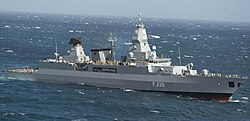Hamburg (F 220)
|
The Hamburg in 2013, as escort for the USS Dwight D. Eisenhower .
|
||||||||||||||||||||
|
||||||||||||||||||||
|
||||||||||||||||||||
|
||||||||||||||||||||
|
||||||||||||||||||||
The frigate Hamburg was from 2000 to 2004 in Kiel at HDW built and on 13 December 2004 as the second ship of Saxony-class put into service. It belongs to the 2nd frigate squadron of the operational flotilla 2 of the German Navy . Their main role is to combat aircraft and other airborne targets to protect naval units and allied forces on land. To do this, it is equipped with very powerful radars and long-range missiles. She can also serve as a flagship for the commander of a battleship formation.
In 2017, a "CDS F124 hardware regeneration" was carried out as part of a stay at the shipyard. The hardware of the Combat Direction System (CDS, corresponds to the command and control system) was renewed and the corresponding software was adapted and modernized.
Calls
From November 2010 to March 2011, the frigate Hamburg was the first ship of its class to be deployed for the EU-led anti-piracy mission EUNAVFOR ATALANTA .
Between March 24, 2013 and June 3, 2013, it coordinated and monitored all aircraft movements within a radius of around 180 km for the aircraft carrier combat group USS Dwight D. Eisenhower (CVN 69) , including all take-offs and landings on the carrier. The USS Hué City (CG-66) also belonged to the aircraft carrier group , so that the three ships formed the US Carrier Strike Group VII . For the first time in the history of the US Navy, a German frigate was entrusted with the sole protection of an American aircraft carrier. The area of operation was the Mediterranean Sea and, after the passage through the Suez Canal, the Arabian Sea and the Persian Gulf .
On February 11, 2014, the Hamburg left its home port Wilhelmshaven ( naval base Heppenser Groden ) together with the frigates Mecklenburg-Western Pomerania , Augsburg , the corvette Oldenburg and the task force supply company Frankfurt am Main in order to take part in the navy's annual operations and training association (EAV) . Until the end of the EAV on June 20, 2014 in Kiel, she participated in several maneuvers between the Arctic Circle and the equator. Thirteen ports in nine countries were called. During this period, she also took part in the 825th Hamburg port birthday (May 9-11, 2014), where she led the parade.
From August 20 to September 4, 2014, Hamburg escorted the American special ship Cape Ray , on which Syrian chemical weapons were destroyed. She guided the Cape Ray through the north-east Atlantic and across the North and Baltic Seas to the ports of destination in Finland and Germany.
On June 8, 2015, the frigate Hamburg, the flagship of Standing Nato Maritime Group 2 (SNMG2), set sail from its home port of Wilhelmshaven towards the Mediterranean. She took part in the major NATO maneuver Trident Juncture and drove as part of Operation Active Endeavor (OAE). On December 20, 2015, she returned to Wilhelmshaven.
Web links
- Official website of the frigate Hamburg
- Portrait on marine-portraits.de
- Podcast about the frigate Hamburg
Footnotes
- ↑ German frigate FGS HAMBURG leaves EU NAVFOR after four months of valuable contribution | Eunavfor. In: eunavfor.eu. Retrieved September 20, 2016 .
- ↑ Marineforum 5-2013, p. 47
- ↑ Strategy & Technology: Frigate HAMBURG released from US aircraft carrier association
- ↑ Press and Information Center Marine: Operation and Training Association in 2014 set to sea. Bundeswehr, February 11, 2014, accessed on March 26, 2014 .
- ^ Mediterranean Sea - MEM OPCW (Maritime Escort Mission Organization for the Prohibition of Chemical Weapons). In: www. Einsatz.bundeswehr.de. Retrieved December 12, 2016 .
- ↑ The frigate "Hamburg" looks back on its mission - report at marine.de , viewed on February 11, 2016.
